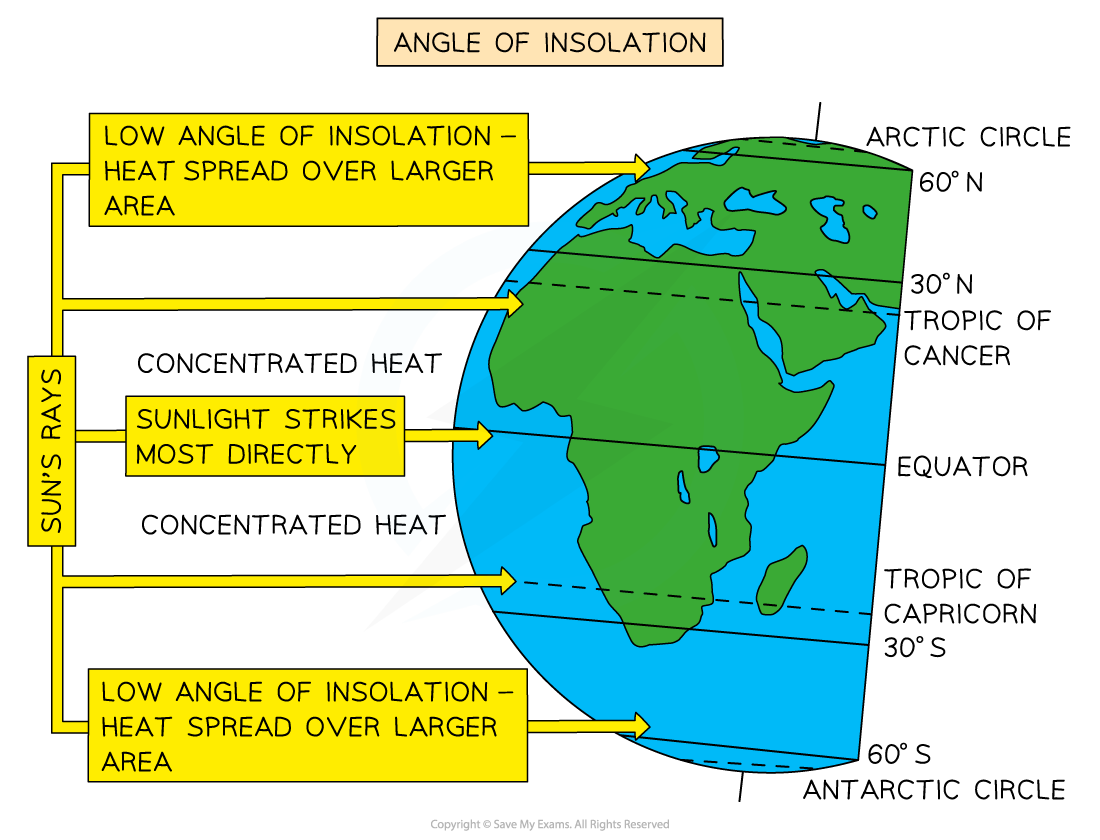Syllabus Edition
First teaching 2015
Last exams 2025
Tricellular Model of Atmospheric Circulation (DP IB Environmental Systems & Societies (ESS)) : Revision Note
Tricellular Model of Atmospheric Circulation
Global Atmospheric Circulation
The global atmospheric circulation can be described as a worldwide system of winds moving solar heat energy from the equator to the poles to reach a balance in temperature
Wind formation
Air always moves from areas of higher pressure to lower pressure and this movement of air generates wind
Winds are large scale movements of air due to differences in air pressure
This pressure difference is because the Sun heats the Earth's surface unevenly
Insolation that reaches the Earth's surface is greater at the equator than at the poles due to the Earth's curvature and angle of the Earth's tilt

Diagram showing how angle of insolation spreads solar radiation over a wider area at the poles than the equator
Hot air rises and cooler air sinks through the process of convection
This irregular heating of the Earth’s surface creates pressure cells
Each cell generates different weather patterns

A typical wind pressure cell system showing distribution of pressure at Earth's surface and upper atmosphere
Air movement within the cell is roughly circular and moves surplus heat from equatorial regions to other parts of the Earth
In both hemispheres, heat energy transfer occurs where 3 atmospheric circulation cells meet
These are the Hadley, Ferrel and Polar cells and are shown via the tri-cellular model:

Heat energy flow and surface winds can be explained using the tricellular model of atmospheric circulation
The tri-cellular atmospheric wind model
Each hemisphere has three cells (the Hadley cell, Ferrel cell and Polar cell) that circulate air from the surface through the atmosphere and back to the Earth's surface
Hadley cell is the largest cell and extends from the equator to between 30° and 40° north and south
Trade winds blow from the tropical regions to the equator and travel in an easterly direction
Near the equator, the trade winds meet, and the hot air rises and forms thunderstorms (tropical rainstorms)
From the top of these storms, air flows towards higher latitudes, where it becomes cooler and sinks over subtropical regions
This brings dry, cloudless air, which is warmed by the Sun as it descends: the climate is warm and dry (hot deserts are usually found here)
Ferrel cell is the middle cell, and generally occurs from the edge of the Hadley cell to between 60° and 70° north and south of the equator
This is the most complicated cell as it moves in the opposite direction from the Hadley and Polar cells; similar to a cog in a machine
Air in this cell joins the sinking air of the Hadley cell and travels at low heights to mid-latitudes where it rises along the border with the cold air of the Polar cell
This occurs around the mid-latitudes and accounts for frequent unsettled weather
Polar cell is the smallest and weakest of the atmospheric cells. It extends from the edge of the Ferrel cell to the poles at 90° north and south
Air in these cells is cold and sinks creating high pressure over the highest latitudes
The cold air flows out towards the lower latitudes at the surface, where it is slightly warmed and rises to return at altitude to the poles

You've read 0 of your 5 free revision notes this week
Sign up now. It’s free!
Did this page help you?

